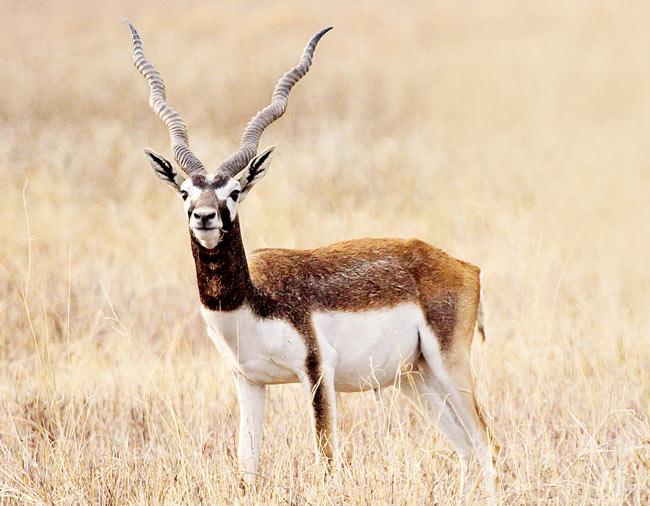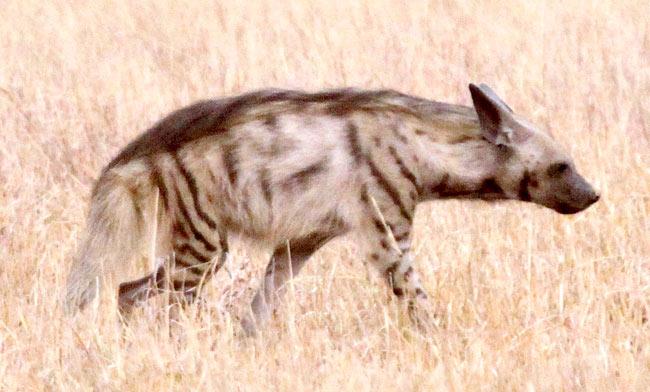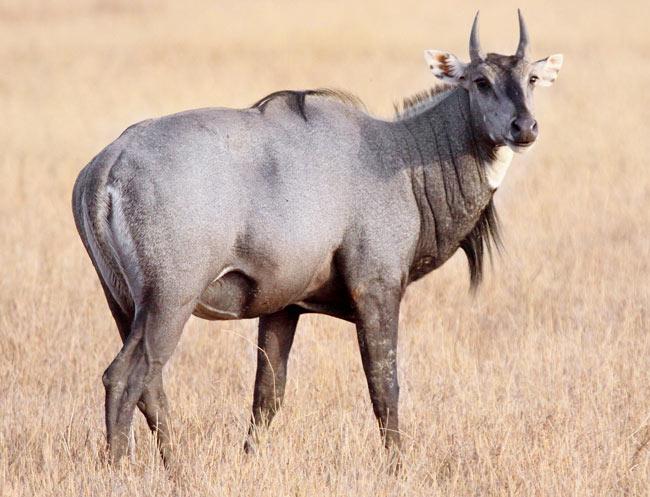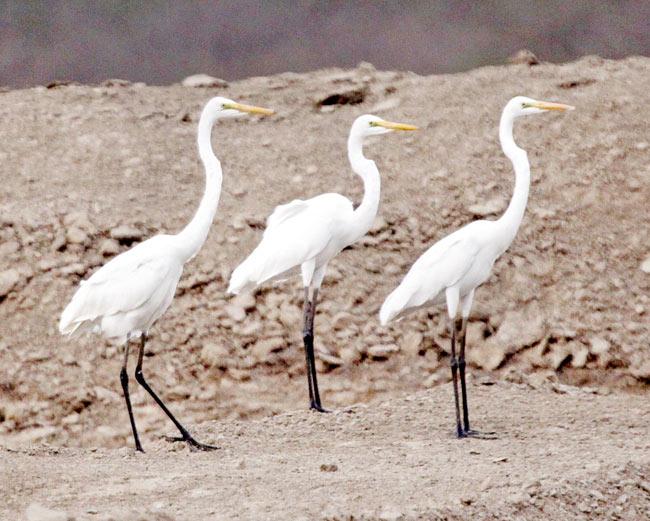The blackbuck is known to be elusive for a reason. After several attempts, C Gangadharan Menon finally spots the majestic antelope in all its glory at Velavadar in Gujarat

Velavadar, Gujarat
You need: 2 days
Best from: Bhavnagar
Best time to visit: October 15-June 15
ADVERTISEMENT
Karnataka. Circa 1993
It was a wild goose chase all right, the very first time I went looking for the elusive blackbuck.
On my journey to Kerala by road, a signboard said, ‘Way to Ranebennur Blackbuck Sanctuary’ and I marched on, unaware that this very sign will waylay my grand plans, and how.

A male blackbuck with his distinct, painted face and spiral antlers, in Velavadar. PICS/C GANGADHaRAN MENON
I set off in the direction of that wretched arrow. But even after driving for a good 30 km, there was no sign of any blackbuck sanctuary, leave alone a lone blackbuck. After another five km and many discreet enquires, I came across a board that announced my destination in big bold letters: ‘Ranebennur Blackbuck Sanctuary’.
Below it, written in a smaller type, was ‘Proposed’.
So much for fine print.
Maharashtra. Circa 2002
It was a decade later that I finally sighted the most beautiful of all Indian antelopes in Rehekuri Blackbuck Sanctuary in Maharashtra. In this tiny island of grasslands floating in the midst of farmlands lived blackbucks, cut off from the nearest herd by a few hundred miles. Here, a small group of four basked in the sun. The male among them was stunning — a sleek body, sharply divided into black and white, a face painted like an aboriginal, and horns spiralling into the blue skies as he lazed in the golden grasslands. Little, I now know, will ever make me forget his august mien.

A female blackbuck ignores the strutting male
Then, very slowly, the numbers in the herd increased till, in one group, it reached a staggering 30.
My guide then told me that their population had almost trebled over seven years then. But naturalists warn that increasing numbers in the wild is not always a healthy sign. It’s actually the health of the herd that truly matters.
Rehekuri is still a teenie-weenie sanctuary, just two sq km area, completely cut-off from other forests. So these animals are practically marooned on this island, and prone to in-breeding. This naturally results in weaker offspring.
To make matters worse, there are no predators here to make sure that only the fittest survive.
Rajasthan. Circa 2009
Jodhpur, the home of many Bishnois, offered me a different spectacle altogether. In the villages here, namely Khejadli, Rotu, Jajiwal and Samrathal, blackbucks co-exist with humans in perfect harmony. The Bishnois revere them, keeping vessels filled with water near their houses for them, even allowing them free access to their ready-to-harvest farms. In fact, a Bishnoi farmer in Jajiwal told me with utmost equanimity, ‘Whatever is left in the farms by the blackbucks is what belongs to us’.

A herd of blackbucks graze in the morning sun
In Khejadli, I met Dr Sumit Dookia who has been researching the relationship between blackbucks and the Bishnois for over a decade. He had a pertinent observation to make. He said that the blackbucks living in and around Bishnoi villages behave differently from those in the wild. Firstly they had started believing that all human beings are Bishnois, and that has put them at tremendous risk, especially with poachers. Another change is seen in the mating rituals. Compared to the elaborate rituals in the real wild, here in the villages they are short and curtailed.
But these are insignificant details when compared to the yeoman service this community has rendered to mankind by conserving an entire ecosystem. Dr Dookia shared with me an interesting fact: There are more blackbucks and chinkaras in Bishnoi villages than in all the wildlife sanctuaries of Rajasthan put together.
Velavadar, Gujarat. May 2014
After all my travels and travails to meet this beast, I can confidently claim that the best place to see blackbucks in their natural glory is Velavadar Blackbuck Sanctuary in south Gujarat. With rolling grasslands stretching up to 32 sq km, it’s our very own Africa, indeed. Nowhere else in India can you find endless grasslands with hundreds of a single species grazing all at once. At the last count, there were over 1,600 blackbucks here, and around 3,000 outside the sanctuary, in nearby protected areas extending up to another 25 km. In fact, a few corridors have been specifically left open for them to migrate, in case of over-population.
 Striped hyena
Striped hyena
It was evening when, this time, we reach the forest guesthouse. Dumping my luggage, I jump into the jeep of the affable Devji Waghela, the Range Officer in charge. The very first sighting is of jackals, the natural predators of blackbuck, who ensure only the fittest of them survive.
Then comes the drama, a typical celluloid romance scene. A majestic male blackbuck tries to woo a nonchalant female. After many romantic overtures, she relents. I see blades of grass leaning on one side in a typically Bollywood gesture.
Soon, it is time for the sun to set, and the blackbucks decide to call it a day. There are divergent groups: a couple of nuclear families, some joint families, a few harems, some bachelor parties, and a few groups of rejected males. But when they settle down to sleep, four members from each group decide to have their forty winks facing four different directions. They, I notice, are the guards, who would warn the group of any attack by predators under the cover of night.
It is a moonless night. Thousands of stars punctuate the black canopy of the sky, and light years peep in through them.

Male nilgai, the largest Indian antelope
The next morning, as the sun rises from the east, the blackbucks rise from the grasslands. From the east, hordes of them cross over to the west, bisecting a dirt track. But for some inexplicable reason, each one of them pauses for a split-second on the track, and then springs across the track in boundless joy. These are the fastest animals on earth after the cheetah, and can cover a distance of 20 feet in a single leap of joy!
Ayub, our guide for that day, takes us to a place, guided purely by his sixth sense. And right there, we spot a striped hyena with jaws strong enough to crush a thighbone. He happily feeds on the leftovers of the night before.
At Velavadar, the dreaded Gando Baval or the ‘Insane Babool’, has been kept on a tight leash by the forest department by uprooting it whenever it rears its ugly, green head. This weed-tree, the seeds of which were imported from Australia and aerially sprayed across Kachchh to increase its green cover a couple of decades ago, has created havoc in Gujarat. And this green cancer has now spread up to Punjab in the north and Karnataka in the south, suffocating the local vegetation and slowly wiping them out.

A trio of stately egrets
That day, as evening descends, so do dark clouds pregnant with rain. A large, white egret cuts through the gathering storm with effortless ease. And then, it pours. The parched, impatient earth takes on newer colours and the petrichor makes us heady. No perfume in the world can match this fragrance, much as they may try to bottle it. Bolts of blue lightning tear through the skies.
Amid all this, I wonder where the shy blackbucks have taken shelter. For now, their lithe figures will have to live on in my memory.
 Subscribe today by clicking the link and stay updated with the latest news!" Click here!
Subscribe today by clicking the link and stay updated with the latest news!" Click here!







